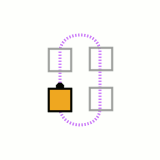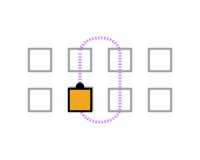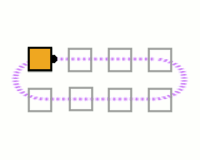Basically, in the matrix model all square and rectangular formations are treated as if they consist of positions in a square grid, like a chess board. The spacing of these positions is considered to be the same for dancers standing next to each other (as in a couple or a wave) as for dancers who are standing one in front of the other (as in a column) or face to face or back to back.
 |
| Taminations does not show equal spacing for many common formations. |
However, looking at formations in terms of a square grid is essential for understanding many aspects of Challenge dancing. It's not that this model is "more accurate". It doesn't mean you need to try to make perfect squares in every formation as you dance. It does mean that you will find it generally helpful to maintain spacing that is more square than is common at lower levels, both to make it easier for everybody to see the positions the same way and to reduce the amount of physical movement involved when the formation changes. And it does mean that for some kinds of formations you really will need to make things pretty close to exactly square.
But most importantly, it is a different way of thinking about formations and positions. It is an abstraction of the properties of formations with which you are already familiar, which makes new ways of thinking about calls possible.
The Idea of a Generalized Box
In beginner class you learned about facing couples, and calls that are natural to do from that starting position, calls like Right and Left Thru, or Flutter Wheel. You also learned about formations consisting of mini-waves, from which you learned to do a Box Circulate or a Scoot Back. There are also calls that start from couples back to back, like Chase Right. But although you learned many calls that moved you from one such formation to another, e.g., Touch 1/4, Walk and Dodge, these formations were almost always referred to by their specific names. |
 |
 |
But once you start thinking about formations with this "square grid" matrix model, you can see that there is a sense in which all of them are the same type of formation. They all consist of 4 spots, arranged in a 2 x 2 grid. The differences among them depend only on the facing direction of the dancers. The thing that they have in common, the abstraction which takes into account only the arrangement of the set of spots, we call the "shape" of the formation.
This particular shape, shared by facing couples, back-to-back couples, and mini-wave boxes, we call "a 4-person box", "a 2x2 box", or simply "a box".
One important implication of this is that, once we free ourselves to think of the spots without regard to facing direction, it then becomes possible to imagine other formations that also have the same "shape", including ones where some of the dancers are facing head walls and others side walls.
 |
 |
 |
These are the so-called "t-bone" formations. Although you may have encountered such cases in Plus or Advanced dancing, where some callers make use of them in the name of "All Position Dancing" or "Dancing By Definition", they become much more important in Challenge dancing.
Larger Shapes
In the same way that we can abstract various specific four-person formations into the more general idea of a "2x2" shape, we can also think of formations like parallel waves, facing lines, and ordinary columns, as well as others with special names like "trade by" or "eight chain", as all being examples of another general shape, a "2x4". |
 |
 |
Again, to envision this you may have to set aside some ways of thinking that you have learned during your past experience in square dancing, about how people naturally space themselves, e.g., in facing lines. You shouldn't try to forget or unlearn those things – they are still things you need to know for actual dancing. It's just that you need to be able to also think of these formations in a different way, as corresponding to a set of spaces of a square grid – and be prepared to adjust your dancing position quickly and automatically to help everybody see it that way when appropriate.
As with a box, once we think about lines and columns that way we can also envision other formations, which have the same "2x4 shape" but for which we don't have familiar names, in which some of the dancers are facing head walls while others are facing side wall. Again, we use the term "t-bone" to refer to these kinds of formations.
 |
 |
The Idea of the "Same" Position
Once you start thinking of the formations that way, you can also think of actions you take in such formations, and actions that turn one such formation into another, in different ways. For example, imagine that you are standing in facing lines, and the caller says "Zig Zag" (or "1/4 Left"). After that you do that, you will find yourself in right-handed columns, a "completely different formation". But where are you standing, after you have completed that call? Did you "move", to a "different position"? |
In terms of your actual physical location, you probably did move. You are now holding hands with somebody, and if you used a tape measure you would almost certainly find that you are standing closer to that person than before, when you had been facing that same person. But viewing the same formations and the same actions in terms of the matrix model, the arrangement of spots has not changed. Each dancer turned 90 degrees, but nobody moved forward, back, or sideways. The "formation" changed, but the "shape" of the formation didn't change. So in terms of that abstract square grid, every dancer is in exactly the same "position" before and after that call.
Line and Column Dancers
Sometimes we want to be able to refer separately to the dancers in a 2x4 that are facing the different pairs of walls. Note that some of them are facing in a direction that would allow them to be part of some kind of 4-person line, if only everybody else were also facing in a consistent direction. The others are standing as if they could be in some kind column, if everybody else were facing in an appropriate direction. |
Notice also that these two groups are completely separate – there is no way you can be facing that would allow you to imagine that you are a part of a line and also part of a column. So we can make use of this fact to name the groups, and you will hear things like "those facing as in lines" or "the column dancers".
Circulates in T-Bone Formations
Doing calls in t-bone formations is essentially just "doing what you would do" if you were standing in "the same position" in a non-t-bone formation. If you are used to thinking of your position in terms of tactile or visual cues – things like holding hands, or looking at a back, or standing face to face with somebody – you will need to learn to abstract those notions too. Simple circulate calls provide a good framework for understanding what you need to know.An "ordinary" Box Circulate is done from a box consisting of two mini-waves, either left-handed or right handed. And you were probably taught at some point that if you are standing behind somebody else, you should "follow that back". But you already know, perhaps from as far back as Mainstream, and certainly from Advanced, that you can also do a Box Circulate from facing couples – it's the same as a Pass Thru in that case. So it isn't whether you are looking at a back that is important – what's important is that you are looking into the box – that you are a trailer. And if you are a trailer, for a Box Circulate you simply step forward, without turning, into the position in front of you. The facing direction of the person currently standing there is irrelevant.
 Similarly, you may have learned that if you are facing out of the box you flip over in the direction of the hand-hold. But that's not really the rule, either. You don't need to actually be holding hands with anybody to know which way to go – all you need to know is whether the rest of the box is to your right or to your left – i.e., whether you are a beau or a belle.
Similarly, you may have learned that if you are facing out of the box you flip over in the direction of the hand-hold. But that's not really the rule, either. You don't need to actually be holding hands with anybody to know which way to go – all you need to know is whether the rest of the box is to your right or to your left – i.e., whether you are a beau or a belle.
Looking at things this way, doing a Box Circulate is the same for a t-bone box as for a non-t-bone box. If you are a lead beau you flip (turning around halfway, 180 degrees) to your right, if you are lead belle you flip to your left, and if you are a trailer you simply step forward without turning. You don't need to learn different rules for t-bone boxes, because the same rules work for ordinary boxes too! The only thing you need to do about the facing direction of everybody else is ignore it – and just "do your part".
That applies equally well to Split Circulate, which is just two halves of a formation doing a Box Circulate.
Eight Person Circulates
On the other hand, for an "All 8 Circulate" (which at Challenge will often be spoken just as "Circulate"), you also need to also take into account whether you are standing "as if in lines" or "as if in columns". That's because the rule for (All 8) Circulate is different for parallel lines vs. columns. In parallel lines (any kind of lines, including waves), the rule is "ends stay ends, centers stay centers" – the dancers in the center box always stay in the center box. But in columns, there is one circulate path that passes through all eight positions, and the circulate can take a center dancer into an end position, and vice versa. |
 |
So which do you do, if the formation is t-boned? You do whichever makes sense for the direction that you are facing. If you are standing "as if in lines", then if you are a center you circulate in the center box (and if you are an end you circulate in the outside box). But if you are standing "as if in columns", then you always step forward into the spot in front of you, unless you are standing as if #1 in a column in which case you flip over just like in a real column.
Once you learn how to do these simple circuate actions correctly from t-bone formations, you will probably have litte difficulty learning to do other calls from such formations, because the same basic principles apply. Just imagine that you are in a complete formation of the appropriate type (columns, waves, or some other kind of lines), and "do your part" accordingly.